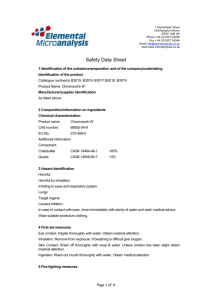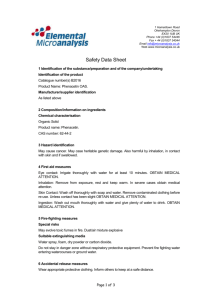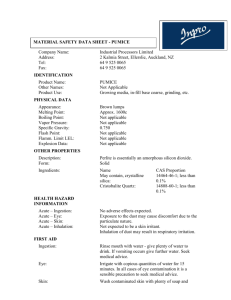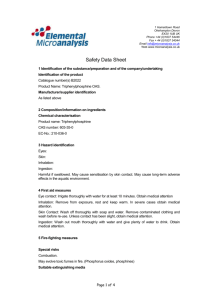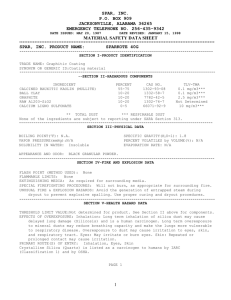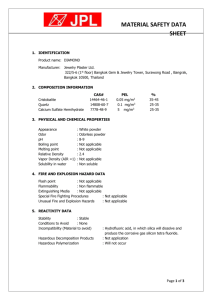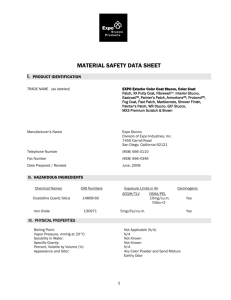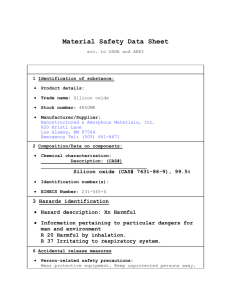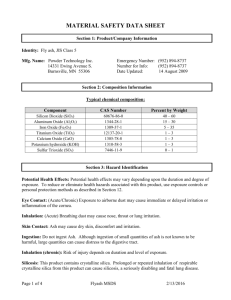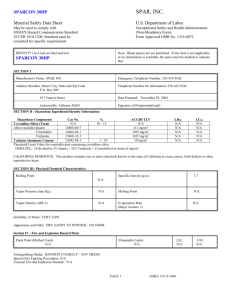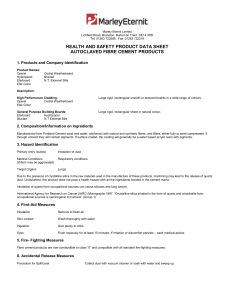Chromosorb P - EA Consumables
advertisement
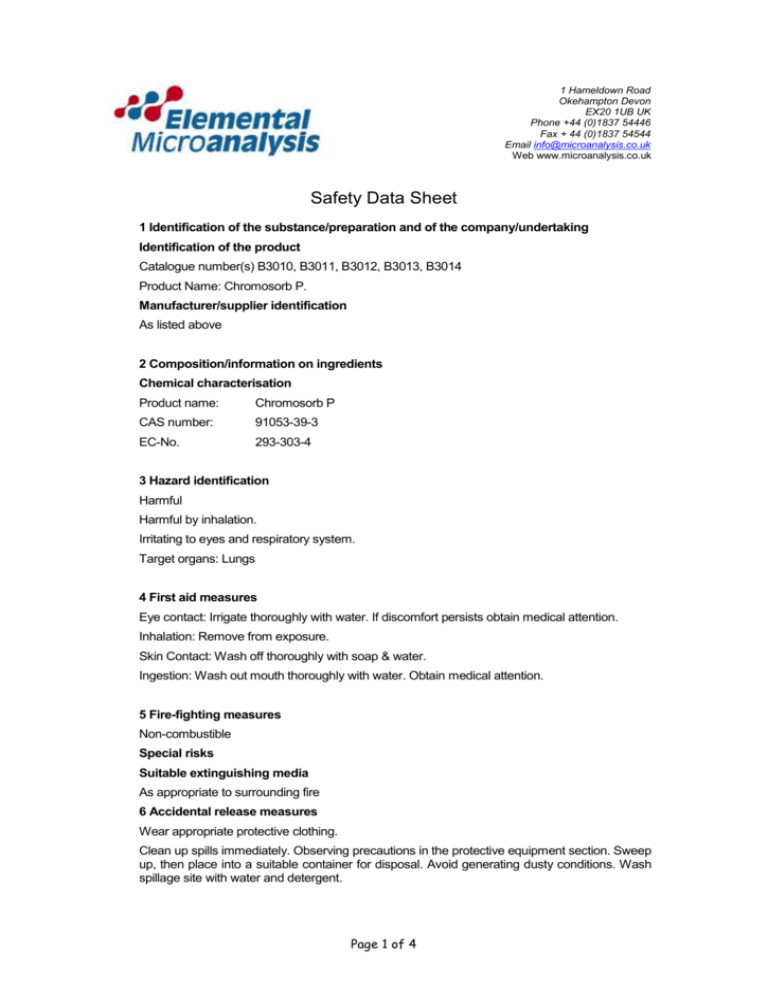
1 Hameldown Road Okehampton Devon EX20 1UB UK Phone +44 (0)1837 54446 Fax + 44 (0)1837 54544 Email info@microanalysis.co.uk Web www.microanalysis.co.uk Safety Data Sheet 1 Identification of the substance/preparation and of the company/undertaking Identification of the product Catalogue number(s) B3010, B3011, B3012, B3013, B3014 Product Name: Chromosorb P. Manufacturer/supplier identification As listed above 2 Composition/information on ingredients Chemical characterisation Product name: Chromosorb P CAS number: 91053-39-3 EC-No. 293-303-4 3 Hazard identification Harmful Harmful by inhalation. Irritating to eyes and respiratory system. Target organs: Lungs 4 First aid measures Eye contact: Irrigate thoroughly with water. If discomfort persists obtain medical attention. Inhalation: Remove from exposure. Skin Contact: Wash off thoroughly with soap & water. Ingestion: Wash out mouth thoroughly with water. Obtain medical attention. 5 Fire-fighting measures Non-combustible Special risks Suitable extinguishing media As appropriate to surrounding fire 6 Accidental release measures Wear appropriate protective clothing. Clean up spills immediately. Observing precautions in the protective equipment section. Sweep up, then place into a suitable container for disposal. Avoid generating dusty conditions. Wash spillage site with water and detergent. Page 1 of 4 7 Handling and storage Handling: Wash hands and face thoroughly after working with material. Avoid breathing dust. Avoid contact with eyes, skin and clothing. Avoid prolonged or repeated exposure. Storage: Store at room temperature (15 to 25c recommended). Keep well closed and protected from direct sunlight and moisture. 8 Exposure controls, personal protection As appropriate to the situation and the quantity handled. Respirator: NIOSH/MSHA Approved respirator. Ventilation: Extraction Hood. Gloves: Rubber or plastic. Eye protection: Safety goggles Other precautions: Plastic apron, sleeves, boots – if handling in large quantities. UK Exposure limits: OES – Magnesium Oxide (as Mg): Total inhalable dust: Long term: 10mg/m3 Fume and respirable dust: Long term: 4 mg/m3 Short term 10mg/m3 9 Physical and chemical properties Form: Solid. Colour: Pink. Odour: Odourless. Melting temperature: No data Solubility in Water: Unknown. No further data 10 Stability and Reactivity: Stable Substances to avoid: Strong acids, Hydrogen fluoride. Hazardous combustion or decomposition products not known. Hazardous polymerisation will not occur. 11 Toxicological information Acute effects: After skin contact: May cause irritation After contact with eyes: Causes eye irritation. After inhalation: Harmful. Irritation to mucous membranes and upper respiratory tract. After ingestion: May be harmful. Prolonged inhalation of crystalline silica may result in silicosis , A disabling pulmonary fibrosis characterised by fibrotic changes and miliary nodules in the lung, a dry cough, shortness of breath, emphysema, decreased chest expansion and increased susceptibility to tuberculosis. In advanced stages, loss of appetite, pleuritic pain, and total incapacity to work. Advanced silicosis may result in death due to cardiac failure or destruction of lung tissue. Crystalline silica Page 2 of 4 is classified as group 2a “ Probably carcinogenic to humans” by IARC and “Sufficient evidence” of carcinogenicity by the NTP. Chronic effects: Target organ(s): Lungs. The product should be handled with the care usual when dealing with chemicals. Further data RTECS # HL8600000 12 Ecological information No Data 13 Disposal considerations Chemical residues are generally classified as special waste, and as such are covered by regulations which vary according to location. Contact your local waste disposal authority for advice, or pass to a chemical disposal company. 14 Transport information Not regulated. (IATA, IMO & RID/ADR) Hazard class – none UN number – not listed Not subject to transport regulations. 15 Regulatory information Labelling according to EC directives Symbol: R-phrases: R20-36/37 Harmful by inhalation. Irritating to eyes and respiratory system. S-phrases: S26-S36 In case of contact with eyes, rinse immediately with plenty of water and seek medical advice. Wear suitable protected clothing TLV and source: Crystalline silica, crystobalite: ACGIH TLV-TWA: 0.05 mg/m3 OSHA PEL: 8H TWA 0.05 mg/m3 respiratable dust. For crystalline silica, Quartz: ACGIH TLV-TWA 0.1mg/m3 OSHA PEL: 8H TWA 0.05 mg/m3 respiratable dust. U.S. Information: California proposition 65: This product is or contains chemical(s) known to the state of California to cause cancer. EC-No. 293-303-4 Local regulations Page 3 of 4 16 Other information Reason for alteration: n/a Revision Date: 1st August 03 Revision number: 0 (First issue) Page 4 of 4
